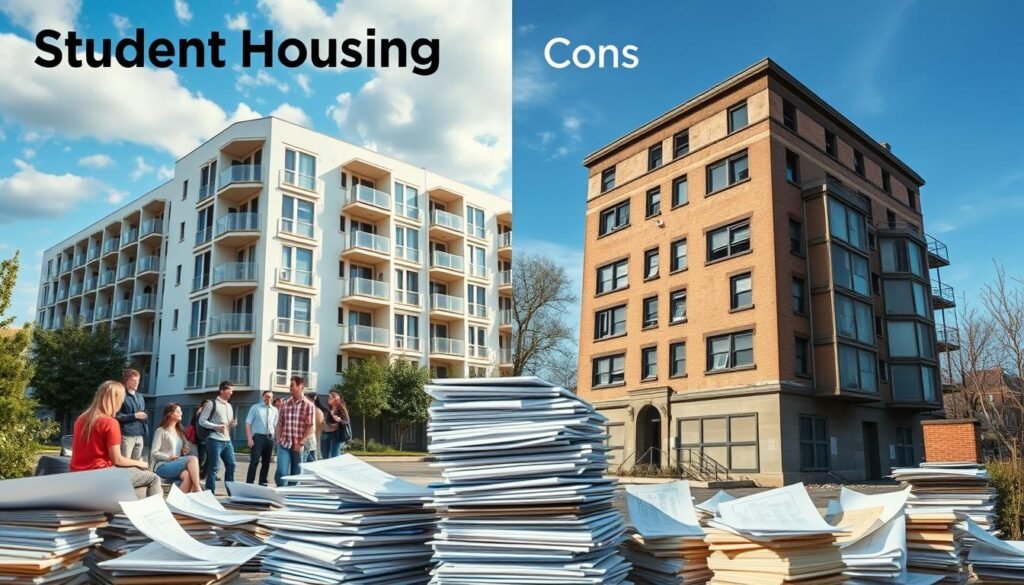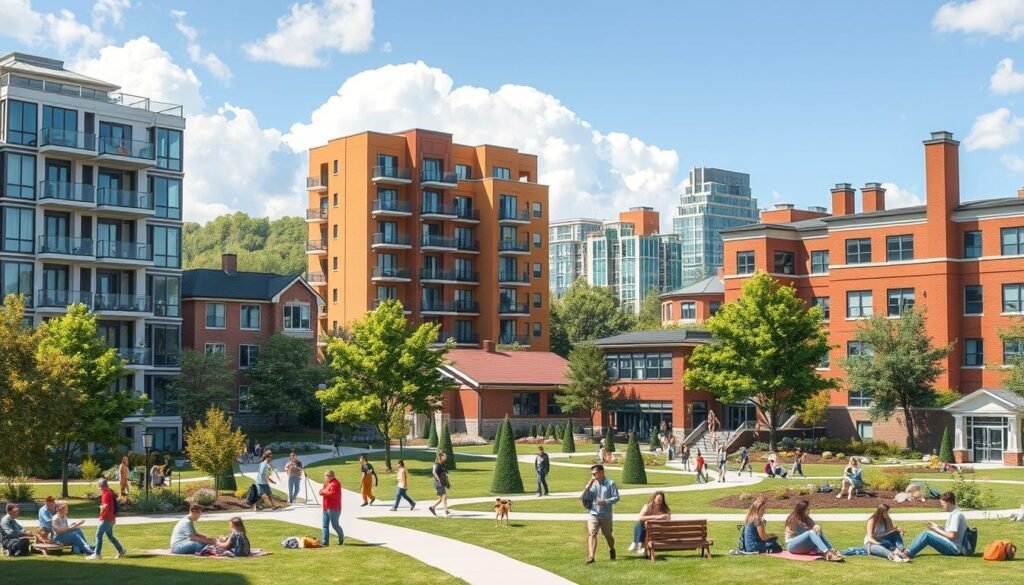The world of property investment is changing fast. Student housing is a unique area that catches many eyes. But is it a smart move or a risky step? With growing demand and special challenges for landlords, it’s key to understand this market well.
Student housing is becoming very popular in the UK. More students are applying to university, showing strong demand. But, it’s important to know the good and bad sides before investing. Things like rules, wear and tear, and demand levels need careful thought.
Key Takeaways
- The UK student accommodation market is currently experiencing a high demand, necessitating around 234,000 additional beds.
- Higher rental yields in student housing can be achieved, often beating traditional property returns.
- Be cautious about summer vacancies and possible damage from inexperienced tenants.
- Student numbers are likely to grow, making it a promising investment area.
- Properties close to universities can get higher rents and more tenants.
- It’s wise to spread your investments to avoid risks in student rentals.
- Knowing the local market well is vital for making smart choices in this field.
Understanding Student Housing Investment
Getting to know the world of student housing investment is key for those looking to invest. It’s about understanding the different places students can live and how these markets work. This knowledge helps investors make smart choices that fit their financial plans. Below, we’ll explain what student accommodation is and the different types, as part of our guide on investing in student housing.
Definition of Student Accommodation
Student accommodation means any place students can live while studying. This includes:
- Traditional university halls
- Private rented housing
- Purpose-built properties designed just for students
There’s a wide range of places students can choose from, based on their needs and budgets. This variety is important for understanding the student accommodation investment analysis.
Types of Student Housing: HMO vs PBSA
When investing in student housing, it’s important to know the main types. Each has its own features:
| Type | Description | Market Dynamics |
|---|---|---|
| Houses in Multiple Occupation (HMOs) | Usually big homes split for students to share, with shared kitchens and bathrooms. | Lower costs to start; could offer higher returns. |
| Purpose-Built Student Accommodation (PBSA) | Modern buildings made just for students, with en-suite bathrooms and common areas. | High demand; rental growth was 2.6% in the 2021/22 year. |
Both types have their own appeal, depending on where they are, how good they are, and what students want. For example, PBSA usually costs more because of its modern features and safe setting. On the other hand, HMOs might be cheaper but offer less. Investors need to think about these differences when deciding on their student housing investments.

Student Housing Market Overview
The student housing market has seen a lot of interest in recent years. This is because more students need good places to live and there are more students than ever. Knowing how this market works is key for anyone thinking about investing.
A student housing market overview shows the current problems with not enough places to live. It also talks about the growth that investors should watch out for.
Current Demand and Supply Dynamics
Big university cities are facing a big problem with not enough places for students to live. There’s about half a bed for every student. In places like London, there’s a need for 100,000 more beds to meet demand.
Rents have gone up a lot, by 8.8% in the last year. This shows there’s a lot of demand but not enough places. This can be both a chance and a challenge for those looking at student housing investment risks.
Future Growth Projections for Student Housing
The future of student housing looks good. It’s expected that more students will want to go to university, with a 41% increase by 2030. By 2026, 2.2 million students will need a place to stay.
This growth means there’s a big gap between the number of places and the number of students. The market is expected to grow to about 9.2 million beds by 2031. This presents both great opportunities and challenges related to student housing investment risks.

Advantages of Student Property Investment
Investing in student accommodation offers many student let investment benefits. These benefits make it very appealing for property investors. They show how you can make a lot of money, mainly in places with lots of students.
No Stamp Duty Advantages
Investors who buy student properties under £125,000 don’t have to pay stamp duty. This makes starting out in the market cheaper. It means you can spend more on fixing up the property or buying more.
Higher and Longer Assured Returns
One key point about pros and cons of student rental properties is the chance for higher earnings. Student homes usually give 8% to 9% in rental income. This is much more than the 4.5% to 5.5% from regular rental properties. Plus, students often rent for 12 months, giving you a steady income for up to five years. This makes your money safer and more stable.
Strong Demand in University Cities
University towns often don’t have enough places for students to live, making student homes very sought after. Around 1.4 students fight for each spot in these special student homes. This shows how reliable and safe investing in student homes can be for landlords.
| Advantage | Description |
|---|---|
| No Stamp Duty | Investment properties under £125,000 have no stamp duty, cutting initial costs. |
| Higher Returns | Gross yields of 8-9% provide excellent return compared to standard buy-to-let. |
| Assured Income | Longer rental periods ensure stable and predictable cash flow. |
| Strong Demand | High competition for accommodation due to limited supply in university areas. |
Disadvantages of Student Property Investment
Investing in student housing comes with its own set of challenges. It’s important to understand the risks of limited capital growth, the difficulties in selling, and the higher wear and tear. These factors give a clearer picture of the disadvantages of student property investment.
Risks of Limited Capital Growth
Investors might see slower value increases in student housing compared to regular rental homes. This means they need to think carefully about long-term growth. It’s a chance to miss out on profits in fast-changing markets.
Challenges in the Resale Market
Selling student homes can be tricky. The market mainly looks for cash buyers, which narrows down the options. This makes it harder to sell and can affect how easily you can get your money back.
Potential for Higher Wear and Tear
Student homes are used a lot, leading to more wear and tear. This means landlords have to spend a lot on upkeep and repairs. They must fix the damage caused by shared living spaces.
| Disadvantages | Description |
|---|---|
| Limited Capital Growth | Slower appreciation compared to traditional properties |
| Resale Challenges | Restricted market mainly for cash buyers |
| Higher Wear and Tear | Increased maintenance costs due to property usage |
Student Housing Investment Pros and Cons
Investing in student housing comes with its own set of benefits and challenges. It’s important to understand the financial risks and rewards. This helps in making informed decisions in this sector.
Comparing upfront costs like property acquisition with the expected yields is key. Also, considering cash flow analysis and future market conditions is vital.
Evaluating the Financial Risks and Rewards
Understanding the financial aspects of student property investment is essential. The gross yield for student accommodation is usually between 8-9%. This is higher than the 4.5-5.5% yields from standard buy-to-let properties.
Student rentals have low vacancy rates. This is because students often sign 12-month leases and plan their housing well in advance. This ensures consistent cash flow for landlords.
Comparative Analysis with Other Investment Types
Comparing student property investment with other types reveals its advantages and disadvantages. Purpose-built student accommodation yields around 8-9%. Social housing investments also yield around 8% or more.
But, social housing is considered lower risk. This is due to reduced tenant turnover and properties being fully renovated. In contrast, large Houses in Multiple Occupation (HMOs) require a big upfront investment for refurbishment and are subject to complex regulations.
The following table shows how student housing compares to other property investments:
| Investment Type | Typical Yield (%) | Risks | Management Requirements |
|---|---|---|---|
| Student Accommodation | 8-9% | Medium (e.g., tenant turnover, seasonal demand) | High (compliance with student needs) |
| Social Housing | 8%+ | Low (stable tenants) | Medium (long-term leases) |
| Standard Buy-to-Let | 4.5-5.5% | Medium to High (market fluctuations) | Medium (general property management) |
Investors need to consider these factors before investing in student housing. The current trend of 1.4 students competing for each purpose-built student bed shows high demand. This makes it a potentially lucrative venture if managed well.
Insights on Managing Student Rentals
Managing student rentals comes with its ups and downs. Knowing your tenants well and managing your property well can make a big difference. This includes finding reliable tenants and managing your property in a way that suits their needs. These steps are key to making the most of your student property investment.
Finding Reliable Tenants
Finding the right tenants is a big task. Here are some tips to help you:
- Work with local letting agents who know the student market well.
- Look at tenant profiles to see if they fit your property’s vibe.
- Use a standard screening process, even for those without credit history.
Importance of Property Management
Good property management is vital for student rentals. Here are some strategies to keep your tenants happy and your property in good shape:
- Make sure your lease agreements are clear and fair.
- Encourage tenants to get renter’s insurance for everyone’s safety.
- Choose affordable materials for renovations to save on costs.
- Fix maintenance issues fast and keep communication open.
In short, a good analysis of student housing and effective tenant management can boost your rental income and reduce risks.
Identifying Prime Locations for Investment
Understanding the student housing market is key to making good investments. Choosing the right place is vital for making money and success. We’ll look at top university cities and how to find areas with lots of student demand.
Recommended University Cities for Investment
Some UK cities are known for their big student populations and lively rental markets. Here are a few:
- Edinburgh: A historic city with lots of students, making it a stable place for renting.
- Manchester: It has many schools and its housing prices are going up.
- Birmingham: This city is growing fast, with more students and chances to invest.
Identifying Areas with High Student Demand
Good investment plans need careful market research. To find areas with lots of student demand, try these steps:
- Talk to local estate agents to learn about new areas and trends.
- Look at university admission numbers. More students mean more demand for housing.
- Do online research on current rents and available properties to find good deals.
In 2020, £5.77 billion was spent on student housing in the UK. This shows the sector’s appeal. With property prices expected to grow by 11.7% by 2027, picking the right location can boost your returns.
Future Outlook for Student Housing Investment
The student housing market is changing, driven by economic trends and new laws. It’s key for investors to know these changes to manage risks well.
Impact of Economic Trends on Student Housing
A Knight Frank study shows more students in the UK, creating a bigger market. Tuition fees and how easy it is to get money for school affect demand a lot. Private investors can meet the need for housing, leading to high occupancy rates.
Student housing often brings in more money than regular properties. With rising costs for living on campus, there’s a growing need for affordable housing near top universities. This trend aims to add nine million beds by 2031.
Legislative Changes Affecting the Market
Investors need to watch for new laws, like stricter rules for HMOs. These changes could raise costs and risks. The UK’s strict fire safety rules also impact property management costs.
Also, talk of rent caps in some areas is a concern for landlords. These laws might cut into profits and make it hard to meet market needs. To avoid risks, investors should diversify and keep up with trends and laws.
| Economic Factors | Potential Impact |
|---|---|
| Increase in student enrolments | Higher demand for rental properties |
| Rising construction costs | Increased operational expenses for landlords |
| Changes in immigration policy | Fluctuations in international student numbers |
| Stricter maintenance regulations | Higher compliance costs for landlords |
Conclusion
Investing in student housing comes with both benefits and drawbacks. It’s key for property experts to grasp these fully. The sector offers high rental yields, mainly in university towns, thanks to steady demand from students looking for affordable homes.
But, investors must watch out for strict rules, zoning laws, and safety standards. These are in place to prevent legal and financial issues.
Long-term leases and steady student presence are attractive. Yet, managing high tenant turnover and upkeep can be tough. Seasonal dips in demand, like during summer, also pose challenges. This makes a detailed guide to student housing investment essential for making smart choices.
In short, understanding the market well is vital. This includes keeping up with economic shifts and law changes. It helps landlords and managers to earn well while avoiding risks in student housing. With more students coming, the future looks bright for those in this field.




